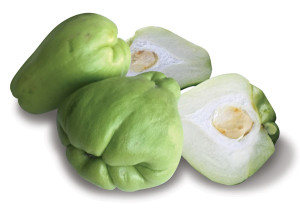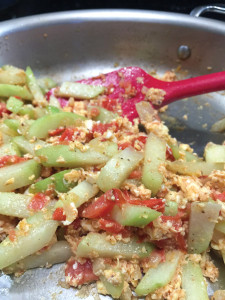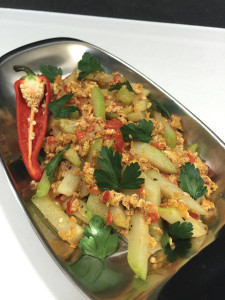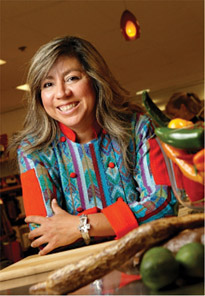AMALIA’S KITCHEN: Squash It!
Though they contain seeds, squash is a vegetable belonging to the cucurbitaceae family native to the North American and Mesoamerican regions. Within the five domesticated species there are many varieties from the United States to Central America. In Guatemala, there are diversities that are still not known elsewhere.
 Pear-shaped, dark-green-skinned güisquil and its albino cousin, perulero, are some of the most common kinds in Guatemalan markets. These can be smooth or prickly. Others are small, young and medium mature güicoy types resembling an American pumpkin in shape, but not in color, flavor or texture. Güicoyito (diminutive for güicoy) is tender young and highly perishable.
Pear-shaped, dark-green-skinned güisquil and its albino cousin, perulero, are some of the most common kinds in Guatemalan markets. These can be smooth or prickly. Others are small, young and medium mature güicoy types resembling an American pumpkin in shape, but not in color, flavor or texture. Güicoyito (diminutive for güicoy) is tender young and highly perishable.
Basically the whole plant is edible, from the tender shoots and flowers to the leaves and fruit. All require different treatment in the kitchen. Cooking with squash (and vegetables) is simple, keeping in mind that they already taste good to begin with. Any cooking needed should be just to lightly enhance and dress them. This way they taste better and retain more nutrients.
Unlike the United States, squashes in Guatemala are widely available and consumed year-round. From a horticultural and historical view, they have been an important crop in the diets of early civilizations both from a nutritional and agricultural perspective.
Corn and beans and squash are well known as the Three Sisters because together they are sustainable and in earlier times, they were organic, not needing pesticides or chemicals to thrive.
 A couple techniques I use in my kitchen involve sautéing and roasting. These entail fast and little cooking, which is ideal when dealing with delicate vegetables. This applies to fruits, too. Squashes in Guatemala are consumed in soups, desserts, stuffed with cheese and in many other ways. The age of the squash usually dictates its treatment in the kitchen. The younger the vegetable, the less the cooking time and handling.
A couple techniques I use in my kitchen involve sautéing and roasting. These entail fast and little cooking, which is ideal when dealing with delicate vegetables. This applies to fruits, too. Squashes in Guatemala are consumed in soups, desserts, stuffed with cheese and in many other ways. The age of the squash usually dictates its treatment in the kitchen. The younger the vegetable, the less the cooking time and handling.
Here’s a recipe using chayote squash (widely available in the United States), using a recipe that I have in my heart from childhood, which can be adapted to other types of young squash. This dish can be a side, a starter, a course or a salad if eaten cold.
¡BUEN PROVECHO!
DELICIA DE CHAYOTE
Squash sauté with tomato-onion-egg scramble
recipe by Amalia Moreno-Damgaard
Serves 2
 1 tbsp. olive oil
1 tbsp. olive oil
1 chayote squash, peeled, diced or cut into long
strips
Pinch of thyme
2 tsp. olive oil
¼ cup finely chopped yellow onion
1 cup diced Roma tomatoes
2 eggs, beaten
Kosher salt and freshly ground black pepper
Parsley leaves
Add one tablespoon of oil to a medium hot skillet. Sauté the squash for 2 minutes, add the thyme and season lightly with salt and pepper. Transfer to a bowl and keep warm.
Add two teaspoons of oil to the skillet and sauté the onion for one minute. Add the tomatoes and sauté one minute and season lightly. Add the beaten eggs and cook until smooth, about 1-1/2 minutes.
Return the squash to the skillet and combine with the egg mixture for one minute.
Serve squash garnished with parsley leaves.
Amalia’s Note
Always wear gloves when peeling chayote squash, as it leaves a thin film on your palms even after washing them thoroughly. When it dries on your hand it has a similar effect as dried glue, which can be removed with lava soap or a rough, wet towel.
Amalia Moreno-Damgaard is an award-winning bestselling chef author born and raised in Guatemala City currently living in the Twin Cities. She provides individuals and companies with a taste and understanding of Latin cultures through healthy gourmet cuisine education, consulting, bilingual speaking and writing and fun culinary experiences. Her cookbook “Amalia’s Guatemalan Kitchen-Gourmet Cuisine With A Cultural Flair” has won 9 international awards. AmaliaLLC.com
